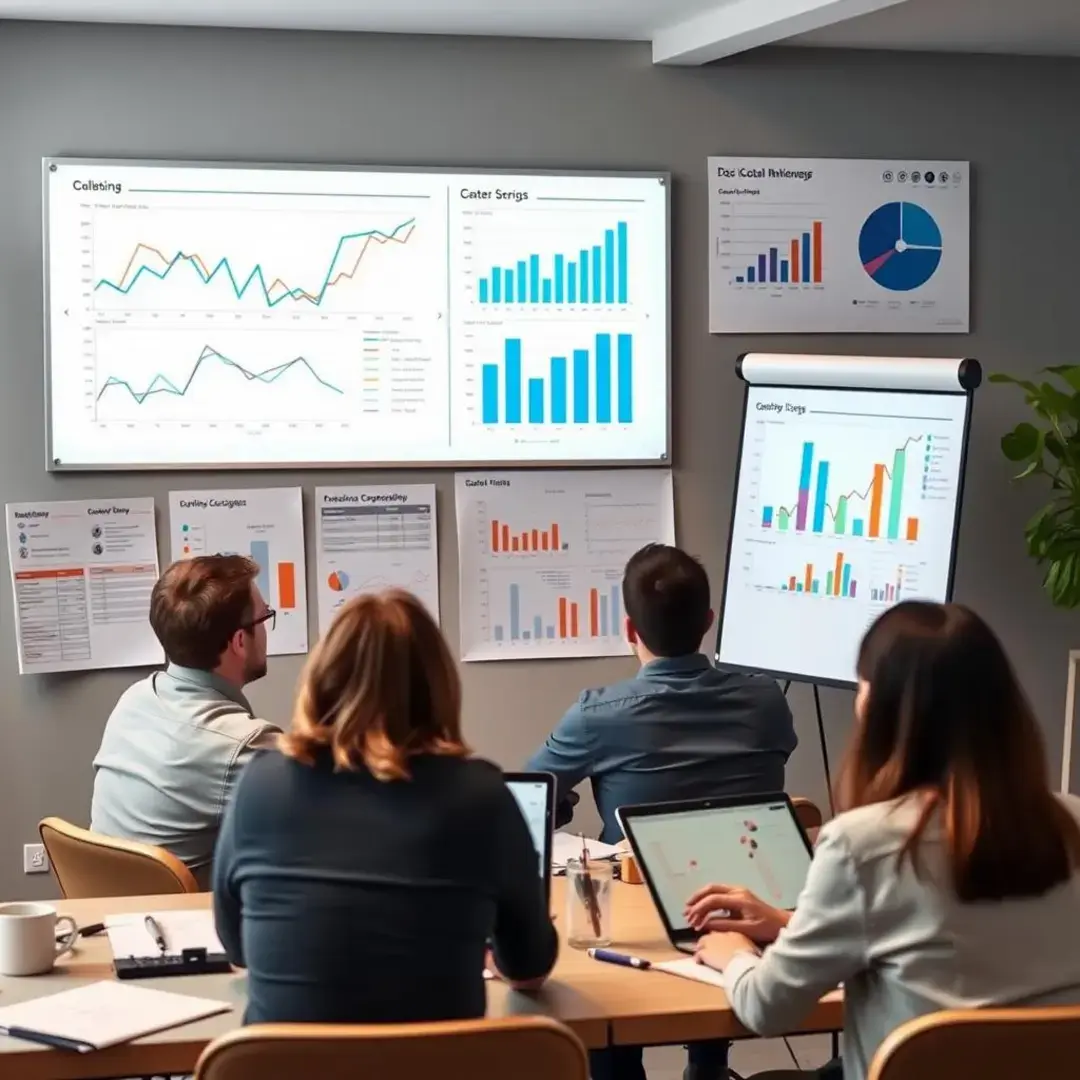Analysis: The Key to Informed Decision-Making
Understanding the Core Principles of Analysis

Defining Analysis in the Context of Decision-Making
In order to make informed decisions, it is essential to engage in a thorough analysis of the situation at hand. This involves breaking down complex problems into smaller, more manageable parts. By dissecting a problem, decision-makers can better understand the various components involved, which is crucial for arriving at effective solutions.
Additionally, this structured approach ensures that no significant factor gets overlooked. A focused analysis can help prioritize issues, allowing for a step-by-step resolution process that enhances clarity and effectiveness in tackling challenges.
At the heart of effective analysis is the ability to identify key factors and variables that influence outcomes. Recognizing what variables are at play is critical, as it allows decision-makers to consider all relevant elements that might impact their choices. Ignoring any of these factors can lead to misguided decisions that may have lasting repercussions.
Whether it’s market trends, consumer behavior, or economic indicators, understanding these components creates a robust foundation for informed decision-making. This identification process involves not just recognizing the obvious, but also being open to discovering hidden variables that may affect the situation.
Once key factors have been identified, it’s important to evaluate their potential impact. Each variable can either promote or hinder progress, and understanding their influence can shape effective strategies. Here, analytical skills play a pivotal role in discerning which factors will likely have the most substantial effect on outcomes.
A comprehensive evaluation allows for a balanced view, making it possible to strategize effectively around the variables that matter the most. This level of scrutiny fosters a proactive mindset, paving the way for decisions that are both informed and strategic.
The Importance of Critical Thinking in Analysis
Critical thinking is an indispensable skill in analysis, particularly regarding decision-making. It promotes objectivity and helps decision-makers avoid biases that can cloud judgment. By critically evaluating evidence and remaining detached from preconceived notions, individuals can derive a more accurate understanding of the situation.
This objectivity fosters a culture of honesty and transparency in the decision-making process, crucial for both individual growth and organizational success. As a result, critical thinking can lead to more effective strategies and ultimately better outcomes.
In the analytical process, challenging assumptions and questioning data becomes vital. Many decisions are based on historical data or common beliefs that may no longer be valid. By scrutinizing these assumptions, decision-makers can reveal insights that lead to more innovative and effective solutions.
This kind of questioning often leads to breakthroughs, prompting new ways to approach old problems. Encouraging an atmosphere where inquiry thrives can significantly enhance the analytical capabilities of a team or organization.
Logical reasoning is at the core of effective analysis. It allows individuals to follow a structured thought process when evaluating information and drawing conclusions. This skill involves recognizing relationships between various pieces of information and utilizing that comprehension to guide decision-making.
Developing strong logical reasoning not only aids in analysis but also bolsters confidence among team members. When decision-making is based on sound logic, it naturally leads to more trust in the decisions made.
Advanced Analytical Techniques for Informed Decisions

Quantitative Analysis Methods
Quantitative analysis methods provide a structured way to investigate numerical data, significantly aiding decision-making. Statistical modeling and forecasting techniques allow businesses to predict future trends based on past data, enabling more strategic planning. Such forecasting tools are essential for navigating the uncertainty that comes with business operations.
By applying these methods, companies can anticipate market changes, consumer preferences, and economic fluctuations, thereby positioning themselves to capitalize on emerging opportunities.
Regression analysis and correlation studies form another key area of quantitative analysis that provides insights into relationships between variables. This analytical technique allows decision-makers to establish how particular factors affect outcomes and to what extent. Understanding these dynamics is crucial for effectively allocating resources and optimizing strategies.
Additionally, it enables businesses to identify which elements drive performance, allowing for targeted interventions that can enhance profitability and efficiency.
Data mining and machine learning applications have revolutionized the way organizations analyze vast amounts of data. These advanced techniques facilitate the discovery of patterns and correlations that would be impossible to identify manually. Consequently, such insights lead to more informed decision-making grounded in real-time data and predictive analysis.
By leveraging these technologies, businesses can respond more adeptly to market conditions and customer needs, ultimately gaining a competitive advantage in their respective industries.
Qualitative Analysis Methods
Qualitative analysis methods, such as SWOT analysis (Strengths, Weaknesses, Opportunities, Threats), provide a comprehensive overview of internal and external factors impacting a decision. This method encourages teams to evaluate their positions critically, laying the groundwork for strategic planning. By understanding their strengths and weaknesses, organizations can leverage their advantages while addressing their vulnerabilities.
Additionally, identifying opportunities and threats enables teams to prepare for potential challenges, fostering a proactive rather than reactive approach.
Scenario planning and contingency analysis are vital methods for navigating uncertainty. By envisioning different possible futures, organizations can develop plans tailored to various potential outcomes. This strategic foresight equips businesses with adaptive strategies, ensuring readiness for changes in the environment.
Moreover, contingency analysis underscores the importance of flexibility in decision-making, allowing leaders to pivot as necessary in response to evolving circumstances.
Utilizing expert interviews and the Delphi method can enhance the quality of qualitative analysis. Engaging with subject matter experts provides invaluable insights that contribute to a deeper understanding of complex issues. The Delphi method, which involves iterative rounds of questions to a panel of experts, encourages consensus-building and fosters a richer exploration of ideas.
This collaborative aspect not only enhances the quality of analysis but also mitigates the risk of individual biases influencing decision-making processes.
Applying Analysis to Real-World Decision Scenarios

Strategic Decision-Making in Business
When it comes to strategic decision-making, market analysis and competitive intelligence resonate deeply. Understanding market dynamics and evaluating the competitive landscape enables organizations to position themselves optimally. This analytical process involves assessing consumer trends, identifying high-performing competitors, and recognizing gaps in the market.
Equipped with this information, businesses can make informed decisions about product development, marketing strategies, and resource allocation, leading to enhanced market positioning.
Financial analysis is essential for evaluating the viability of investment decisions. Comprehensive financial assessments provide insights into profitability, risks, and potential returns, allowing decision-makers to weigh the merits of various options logically. A thorough understanding of financial data not only aids in resource management but also promotes responsible investment practices.
Consequently, it ensures that organizations can navigate financial landscapes adeptly and capitalize on opportunities for growth.
Risk assessment is paramount in any analytical process, particularly for high-stakes decisions. By identifying potential risks associated with a decision and analyzing their potential impact, organizations can develop effective mitigation strategies. This proactive approach preserves resources and underpins sound decision-making, promoting long-term success.
Ultimately, effective risk management fosters resilience, as it prepares organizations to adapt to challenges and seize opportunities as they arise.
Policy Analysis and Public Decision-Making
For public decision-making, conducting a thorough policy analysis through cost-benefit analysis and impact assessments is vital. This analytical framework evaluates the economic, social, and environmental implications of various policies, fostering informed choices that benefit the public. Understanding potential costs and benefits helps policymakers make decisions that align with the community’s best interests.
A well-structured analysis can lead to more effective policies, ensuring that resources are allocated where they can have the most significant positive impact.
Engaging stakeholders in the decision-making process is essential for successful policy analysis. Understanding their needs, concerns, and perspectives creates more inclusive and effective policies. Through stakeholder analysis, decision-makers can gather insights that foster buy-in while addressing concerns that might impede implementation.
This comprehensive analysis promotes greater transparency and accountability, ultimately resulting in better outcomes for all parties involved.
Evidence-based policy development is founded on the principles of rigorous analysis. By relying on empirical data and proven methodologies, policymakers can devise interventions that are both effective and sustainable. This method shifts the focus from intuition or anecdotal evidence to data-driven decisions, thereby enhancing the efficacy of public policies.
Ultimately, such evidence-based strategies foster public trust and yield long-term benefits for society as a whole.
Enhancing Your Analytical Skills for Better Decisions

Developing a Structured Approach to Analysis
A structured approach to analysis begins with framing the problem and defining clear objectives. This initial step sets the stage for a successful analytical process by ensuring that the analysis remains focused and relevant. Clearly articulated objectives help guide the collection of data and the selection of appropriate analytical methods.
Taking the time to precisely frame issues can minimize confusion later on, ultimately leading to more effective solutions and strategies.
A crucial part of any analysis is the gathering and organizing of relevant data. High-quality data is the backbone of sound analysis, and the way it is organized determines its usability. Establishing a systematic method for collecting and managing data not only streamlines the analysis process but also enhances the reliability of the results.
When data is well-organized, it further facilitates meaningful insights, paving the way for data-driven decisions that are more impactful.
Synthesizing information is the next step after gathering data. This involves integrating various data points, identifying patterns, and drawing conclusions that inform decision-making. A rigorous synthesis process helps ensure that no vital detail is overlooked, bolstering the accuracy and relevance of the conclusions drawn.
Finally, generating actionable insights based on the synthesis allows individuals and organizations to make informed decisions that are grounded in comprehensive analysis, ultimately resulting in more effective strategies.
Utilizing Analytical Tools and Technologies
Utilizing data visualization and reporting software can greatly enhance the effectiveness of analysis. These tools convert complex data sets into easily digestible formats, making it simpler to identify trends and patterns. By translating intricate data into visual representations, decision-makers can communicate insights more clearly and compellingly.
This clarity fosters better collaboration among stakeholders, leading to informed discussions that drive decisions forward.
Decision support systems and expert systems are invaluable resources for enhancing analytical capabilities. These platforms often integrate data analysis techniques with computational models to assist decision-makers in evaluating options. They can process extensive amounts of data quickly, providing users with actionable insights that inform choices.
By leveraging these innovative systems, organizations can improve their responsiveness to challenges and opportunities in their respective sectors.
Advanced analytics platforms and cloud-based solutions further extend the capabilities of organizations in their analytical pursuits. These technologies offer powerful analytics tools and access to vast data repositories that facilitate informed decision-making. With cloud-based solutions, teams can collaborate seamlessly across geographies, enhancing the analysis process.
This technological integration not only optimizes resource utilization but also positions organizations to adapt swiftly to an ever-changing business landscape.












